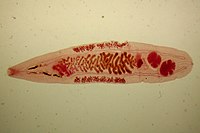
Characterization of the mitochondrial genome sequences of the liver fluke Amphimerus sp. (Trematoda: Opisthorchiidae) from Ecuador and phylogenetic implications.
Sign Up to like & getrecommendations! Published in 2019 at "Acta tropica"
DOI: 10.1016/j.actatropica.2019.04.025
Abstract: Amphimerus Barker, 1911 is a liver fluke infecting several animal species and humans. Being a digenetic trematode of the Opisthorchiidae family, Amphimerus is closely related to the genera Metorchis, Clonorchis and Opisthorchis. Recently, a high… read more here.
Keywords: liver fluke; opisthorchiidae; genome sequences; amphimerus ... See more keywords

Co-infections with liver fluke and Helicobacter species: A paradigm change in pathogenesis of opisthorchiasis and cholangiocarcinoma?
Sign Up to like & getrecommendations! Published in 2017 at "Parasitology international"
DOI: 10.1016/j.parint.2016.11.016
Abstract: Infection with the fish-borne liver fluke Opisthorchis viverrini is classified by the International Agency for Research on Cancer as a Group 1 carcinogen: definitely carcinogenic in humans. Cofactors likely contribute to bile duct cancer (cholangiocarcinoma)… read more here.
Keywords: liver fluke; infection; cholangiocarcinoma; fluke helicobacter ... See more keywords

Opisthorchiasis in Western Siberia: Epidemiology and distribution in human, fish, snail, and animal populations.
Sign Up to like & getrecommendations! Published in 2017 at "Parasitology international"
DOI: 10.1016/j.parint.2016.11.017
Abstract: Opisthorchiasis is a widespread helminth infection in Russia. The largest opisthorchiasis endemic focus in the world is the Ob river watershed in Western Siberia. The main causative agent of this condition is the liver fluke,… read more here.
Keywords: western siberia; liver fluke; opisthorchiasis; epidemiology ... See more keywords

Vaccination against Fasciola hepatica using cathepsin L3 and B3 proteases delivered alone or in combination.
Sign Up to like & getrecommendations! Published in 2018 at "Veterinary parasitology"
DOI: 10.1016/j.vetpar.2017.12.007
Abstract: No licensed vaccine is currently available for prevention of Fasciola hepatica infections. However, considering the alarming increase in drug resistance, there is an urgent need for a safe and fully effective vaccine against fasciolosis. Here,… read more here.
Keywords: liver fluke; alone combination; fasciola hepatica; vaccine ... See more keywords

Development of a multiplex quantitative PCR assay for detection and quantification of DNA from Fasciola hepatica and the intermediate snail host, Austropeplea tomentosa, in water samples.
Sign Up to like & getrecommendations! Published in 2018 at "Veterinary parasitology"
DOI: 10.1016/j.vetpar.2018.06.018
Abstract: Liver fluke (Fasciola hepatica) infection is an increasing threat to livestock production resulting in serious economic losses to the beef, dairy and sheep industries in Australia and globally. Triclabendazole (TCBZ) is the main drug used… read more here.
Keywords: liver fluke; detection; dna; water ... See more keywords

Structural Variants of a Liver Fluke Derived Granulin Peptide Potently Stimulate Wound Healing.
Sign Up to like & getrecommendations! Published in 2018 at "Journal of medicinal chemistry"
DOI: 10.1021/acs.jmedchem.8b00898
Abstract: Granulins are a family of growth factors involved in cell proliferation. The liver-fluke granulin, Ov-GRN-1, isolated from a carcinogenic liver fluke Opisthorchis viverrini, can significantly accelerate wound repair in vivo and in vitro. However, it… read more here.
Keywords: variants liver; wound healing; liver fluke; fluke derived ... See more keywords

Infection with Opisthorchis felineus induces intraepithelial neoplasia of the biliary tract in a rodent model
Sign Up to like & getrecommendations! Published in 2017 at "Carcinogenesis"
DOI: 10.1093/carcin/bgx042
Abstract: The liver fluke Opisthorchis felineus is a member of the triad of epidemiologically relevant species of the trematode family Opisthorchiidae, and the causative agent of opisthorchiasis felinea over an extensive range that spans regions of… read more here.
Keywords: biliary tract; liver fluke; opisthorchis felineus; infection ... See more keywords

Transcriptomic landscape of hepatic lymph nodes, peripheral blood lymphocytes and spleen of swamp buffaloes infected with the tropical liver fluke Fasciola gigantica
Sign Up to like & getrecommendations! Published in 2022 at "PLoS Neglected Tropical Diseases"
DOI: 10.1371/journal.pntd.0010286
Abstract: The tropical liver fluke Fasciola gigantica is a parasitic helminth that has been frequently reported to infect mammals, typically involving water buffaloes. In this study, we characterized the tissue transcriptional landscape of buffaloes following infection… read more here.
Keywords: tropical liver; fluke fasciola; hepatic lymph; fasciola gigantica ... See more keywords

Identification and Analysis of the Tegument Protein and Excretory-Secretory Products of the Carcinogenic Liver Fluke Clonorchis sinensis
Sign Up to like & getrecommendations! Published in 2020 at "Frontiers in Microbiology"
DOI: 10.3389/fmicb.2020.555730
Abstract: Liver fluke proteins, including excretory-secretory products (ESPs) and tegument proteins, are critical for the pathogenesis, nutrient metabolism, etiology and immune response of liver cancer. To understand the functions of various proteins in Clonorchis sinensis physiology… read more here.
Keywords: sinensis; liver fluke; excretory secretory; tegument ... See more keywords

Calicophoron daubneyi—The Path Toward Understanding Its Pathogenicity and Host Interactions
Sign Up to like & getrecommendations! Published in 2020 at "Frontiers in Veterinary Science"
DOI: 10.3389/fvets.2020.00606
Abstract: Infections by parasitic flukes are an important animal health and production concern for livestock producers worldwide. In the UK, and throughout the EU, liver fluke (Fasciola hepatica) historically has been a major focus for livestock… read more here.
Keywords: liver fluke; calicophoron daubneyi; hepatica; pathogenicity ... See more keywords

Liver Proteome Alterations in Red Deer (Cervus elaphus) Infected by the Giant Liver Fluke Fascioloides magna
Sign Up to like & getrecommendations! Published in 2022 at "Pathogens"
DOI: 10.3390/pathogens11121503
Abstract: Liver fluke infections are recognised as diseases with worldwide distribution and considerable veterinary and public health importance. The giant liver fluke, Fascioloides magna, is an important non-native parasite which has been introduced to Europe, posing… read more here.
Keywords: fascioloides magna; fluke fascioloides; red deer; giant liver ... See more keywords